
Use this guide to help you charge faster, understand how Supercharging works, and more! (Jun-2025 Update)
Which Supercharger Location?
In many situations, there will only be one choice on your travel route. Sometimes there are multiple closely spaced Supercharger locations that allow you the advantage of selecting a specific location. There are several strategies to consider when you have multiple choices.
Select the location that leaves you with the lowest State of Charge (SOC), along with some safety buffer. This is a good choice for longer trips, as the charging is fastest at low SOC levels.
Select the location with the freest stalls. This avoids a potential wait, and you’re more likely to find a pair of stalls that are free, which speeds your charging.
Select the location with the amenities you want such as restrooms, food, coffee, and shopping.
Tap the map and select the Supercharger lightning icon near the bottom. It lists Superchargers near you on the left in order of distance from your current location. The map also shows where Superchargers are available with a red pin. The number in the pin shows available stalls at that location. A clock appears in the pin if the location is full. View additional Supercharger information on the navigation map by tapping any red Supercharger pin. It shows the total number of stalls, those that are free, and a list of amenity icons. If the location is full, it estimates the wait time too.
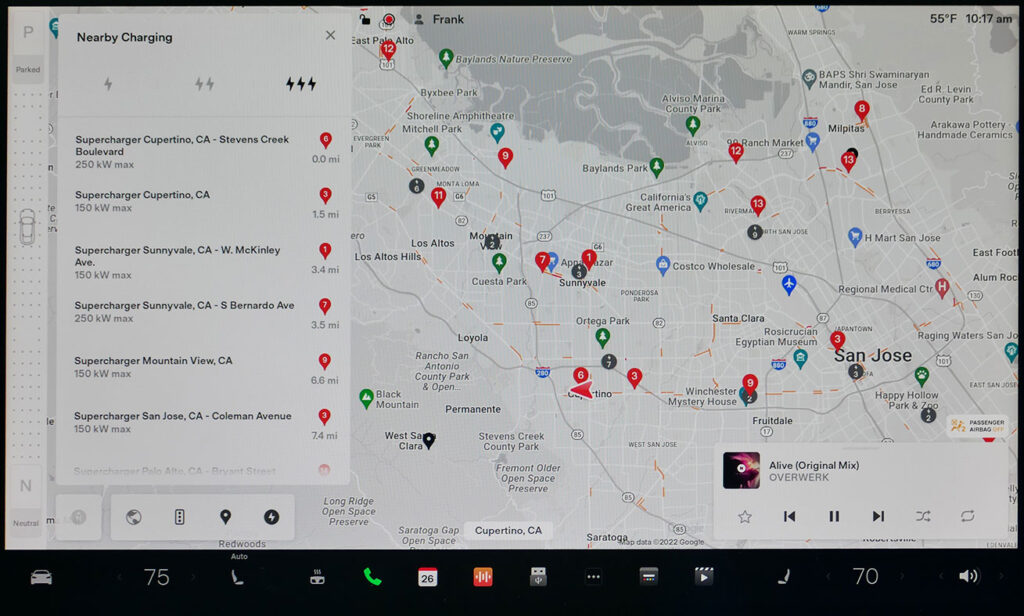
On the map, tap a Supercharger pin to get additional details for that location. This includes status and outages, fees, distance to the location, and various amenities. In this example, the icons show this location has restrooms, restaurant, coffee shop, hotel/motel, shopping and WiFi.
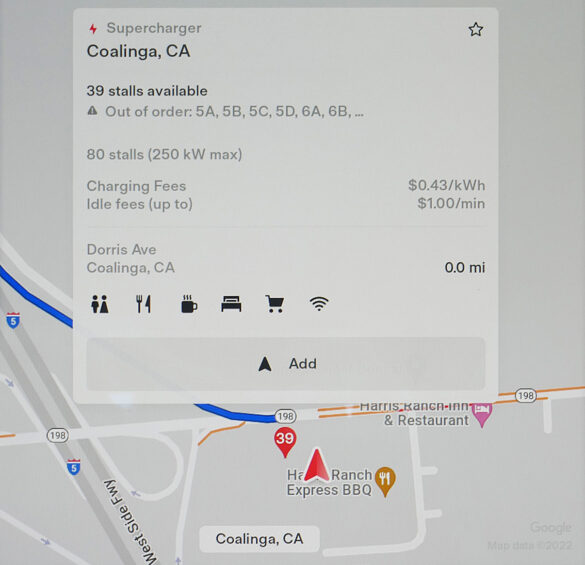
Picking the Right Stall
At a busy Supercharger, you can often dramatically speed up your charging by picking the right stall. At an empty location, any stall should offer the maximum charging speed. At a busy one, if you have more than one choice, the wrong choice might take you considerably longer to charge!
First, if the Supercharger has V4 stalls, these will always be the best choice. They are not shared and for the Cybertruck, the peak charge rate is 325 kW.
Next, if the Supercharger has V3 stalls, these will always be the best choice. They are not shared and for new vehicles, the peak charge rate is 250 kW.
Many locations still use V2 Superchargers. Each group of two stalls is connected to a single V2 Supercharger cabinet. Each cabinet has a number and the pedestals in each stall are labeled with that number and A or B. Now for maximum charging speed, you want to select a stall where you will be the only vehicle at A and B for that Supercharger cabinet.
When vehicles occupy both stalls for a single V2 Supercharger cabinet, the power is divided between the two vehicles. The first vehicle gets the most power, but the second vehicle will get at least 30 kW. As the first vehicle charges beyond 50% SOC or so, the power is tapered down to protect the battery. The excess capacity is then diverted to the 2nd vehicle. When the first vehicle completes charging or leaves, the second vehicle gets the entire capacity of the Supercharger.
In most locations, the A and B stalls for the V2 Supercharger cabinet are adjacent to each other. You do have to look, as some locations seem almost random as to the stall layout.
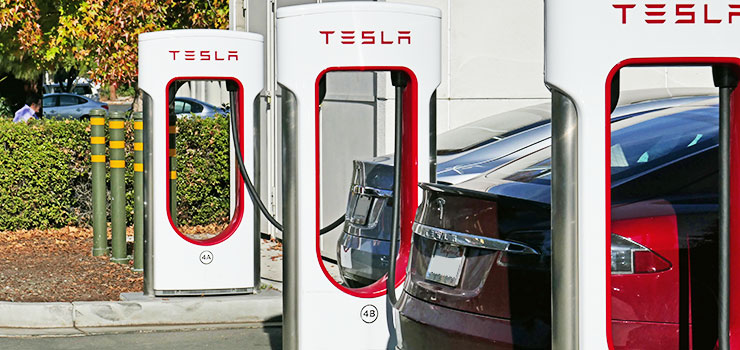
If the only open stalls are ones that have a vehicle in the adjacent pair, look for a stall where the vehicle that has been charging for a while. This is not easy to determine, short of asking drivers that might still be in their cars or nearby. Another trick is to choose a stall where the adjacent vehicle is a Model 3 SR or an S/X 60 or 75. All these will top out at 120 kW or less, which means more power for you sooner.
Supercharging with a trailer
Tesla vehicles with a trailer pose a tricky problem at Superchargers. Clearly you can detach the trailer and use any stall, but in some locations, it may be possible to keep the trailer attached. It’s also possible in some locations to go across a long group of stalls to charge, but it blocks other vehicles from using those stalls. Only do this if there are plenty of other open stalls available for other owners. Please be considerate. Also, check out this list of trailer friendly locations at TMC.
Opening the Charge Port Door
The easiest way to open the charge port door on any Tesla is to press the release button on the charging connector. On some vehicles, you may need to press the button while holding the connector a foot or two behind the door or above it so the vehicle’s antenna sees the signal.

You can also release the door from the Tesla app on a smartphone. Select CHARGING and tap the UNLOCK CHARGE PORT button.
Other ways to release the charging port door depends on the vehicle:
Model 3 and Model Y
- While the car is unlocked, or an authenticated phone is nearby, tap the bottom of the charge port door
- On the touchscreen, tap the charging icon and press OPEN CHARGE PORT
Model X and Model S with newer self-closing charge port door
- While the vehicle is unlocked, tap the front of the charge port door
- On the fob, hold the trunk button for 1-2 seconds
- On the touch screen, tap CONTROLS, then Charge Port
Model S with older manual closing charge port door
- On the fob, hold the trunk button for 1-2 seconds
- On the touch screen, CONTROLS, then Charge Port
Port States and Colors
On the Model 3/Y and the S/X made after April 2022, there is a small Tesla logo that lights up to the left of the port. On older S/X, the ring around the charging port changes colors to indicate what is going on. In European older S/X, the charge indicator to the right side with 3 LEDs (not shown).
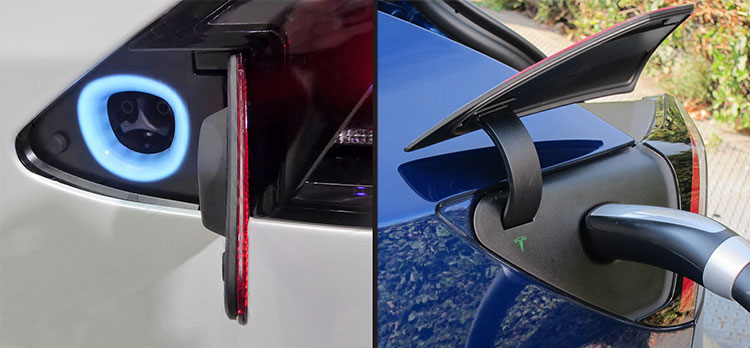
| State | Meaning | Action |
|---|---|---|
| White/Light blue | Unlocked | Ready for insertion or removal |
| Deep Blue | Connected, not charging | Indicates the charging will start at a later time |
| Green – Solid | Connected, fully charged | |
| Green – Pulsing | Connected, charging | Pulses slow down as it nears completion of charging |
| Amber – Solid | Not fully plugged in | Remove and insert |
| Amber – Blinking | Reduced AC charging | Possible line voltage sag at higher currents, so power was reduced for charging |
| Red | Fault | See the instrument cluster for a description of the error as no charging will occur |
The Tesla Semi uses a new connector, which supports 1 MW fast DC charging.
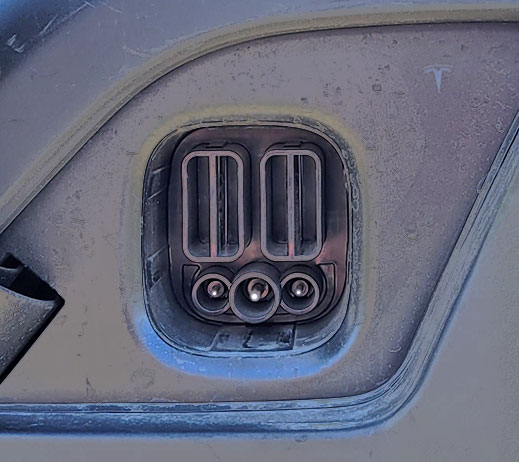
Understanding the Main Charging Screen
When charging, the screen(s) will show various charging information – including an estimate of how long it will take to reach your desired charge level. Depending on the model, one of the screens will show you the current charging power, the charging rate and how many miles have been gained since you started charging.

When you navigate to a Supercharger, the car will automatically precondition the battery to improve the starting charging rate. If the battery is cold, the battery will need to be heated before charging can begin or you may find charging speed is limited until the battery is heated.
To minimize the time at a Supercharger, if you do not need more than 80% SOC, stop charging earlier to dramatically reduce the charging time. We’ll talk more about this below in the Tapered Charging section.
I recommend checking the screen (or the phone app) a couple of minutes after you connect to a supercharger. In rare cases, the charging may stop or have much lower power than desired, and it’s best to know about it quickly so you can resolve it.
Maximum Charging Power
By Vehicle Battery
The vehicle battery pack size and battery cell design limit the maximum charging power. Unless otherwise stated, maximum charging power is DC via the Supercharger.
Tapered Charging
Tesla changes the amount of power used to charge up the pack, depending, in part, on the State of Charge (SOC). When the vehicle is below 45% SOC, the taper curve starts at 10-15 kW below the maximum, and quickly move to the maximum power, where it starts to taper off around 45% SOC and drops to zero when fully charged.
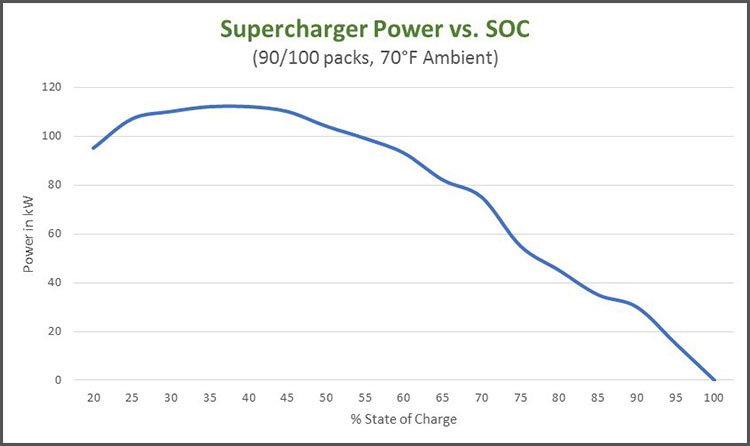
This means is you get the fastest charging when you are in the range of about 20% to 55% and then it slows down the closer you are to 100%. When travel requires multiple Supercharger stops, the best plan is to stop charging when you have enough power to reach your next charging stop, plus a 10-20% reserve. Of course, in very cold weather a larger reserve is necessary.
The chart above is for the 100 packs made today when Superchargers were limited to 120 kW. The 75 packs follow a similar curve but are limited to about 115 kW max. The 2nd gen 60 packs are really a 75 pack and charge at the same rate as a 75. This special case stops charging when the real pack SOC reaches about 80% SOC and is shown within the vehicle as 100% SOC.
Most older packs with the original battery formulation, such as the 40/60 (1st gen)/70/85 start to taper off earlier and the early 40/60 packs may be limited to about 105 kW.
This next chart shows a Model 3 at a v2 Supercharger pulling close to 150 kW.
| Vehicle | Pack Voltage | Max Charging Power |
|---|---|---|
| Roadster – Original | 375 V | 16.8 kW (AC only) |
| S85 with “A” Battery (2012, early 2013) | 400 V | 90 kW |
| S40/S60/X60/S70/S75/X75 | 350 V | 105-122 kW (older models ~90-95 kW) |
| S85/S90/X90 | 400 V | 120 kW |
| S100/X100 | 400 V | 150 kW |
| S/X Standard Range | 350 V | 122 kW |
| S/X Long Range (mfg after April 2019 to 2020) | 400 V | 200 kW |
| S/X Long Range Plus | 400 V | 225 kW |
| S/X Long Range Plus (mfg after July 2020) | 400 V | 250 kW |
| S/X Long Range and Plaid (mfg after June 2021) | 450 V | 250 kW |
| Model 3 – Long Range, Performance | 350 V | 250 kW |
| Model 3 – Medium Range | 350 V | 200 kW |
| Model 3 – Standard/Standard Plus | 350 V | 170 kW |
| Model Y – Long Range, Performance | 350 V | 250 kW |
| Model Y – Standard Plus | 350 V | 170 kW |
| Cybertruck | 800V | 325 kW |
| Roadster 2025 | 800V* | 325 kW* |
| Semi | 800V* | 900 kW* |
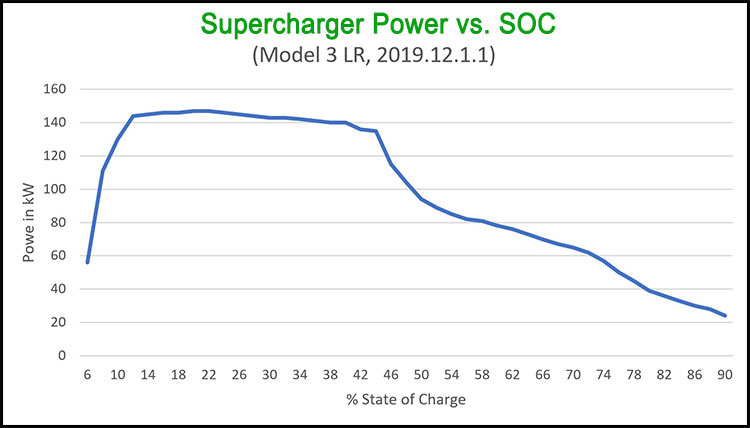
This chart shows a Model 3 charging at a V3 250 kW Supercharger.
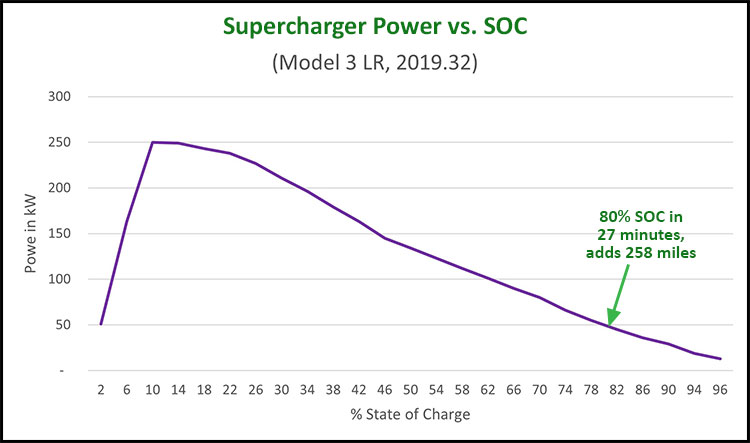
This last chart shows a Model S Plaid also at a V3 250 kW Supercharger
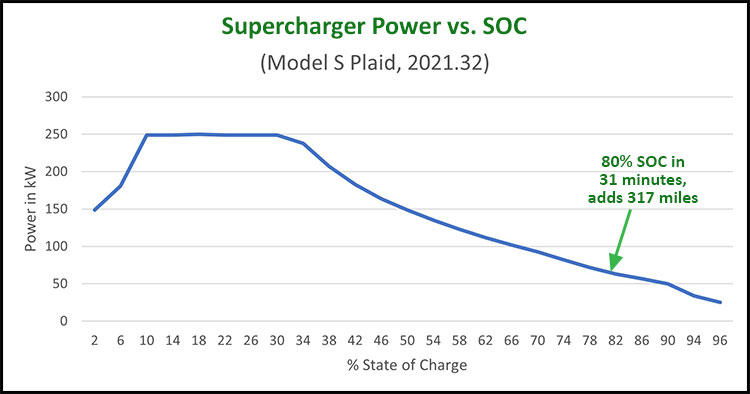
Tesla uses the tapering technique to provide the fastest charging without damaging the batteries or reducing longevity. A typical consumer item like a phone usually charges at the maximum rate from start to finish, which often leads to the battery degrading quickly, and needing replacement in a couple of years.
Temperature Considerations
The best case is shown above in the first tapered charging graph at 70°F. If the battery pack is either too cold or too hot, the power will be further reduced until the pack temperature gets within the safe fast-charging range. The vehicle’s HVAC system is used to cool or heat the battery during this period. Charging at the best rate usually occurs within 5 to 10 minutes.
When navigating to a Supercharger and you get close to the Supercharger, if there is sufficient SOC, the car will heat the battery pack to the optimum charging temperature. This ensures the charging can begin at the maximum rate for the SOC. You will see a “Preconditioning” note at the top of the navigation pane.
While rare, the Supercharger itself may limit the power if its own electronics are too hot. This is fairly rare but might occur if ambient temperatures are above 110°F and 100+ kW is being drawn from the Supercharger cabinet for an extended period.
Charging Speed Reduction from DC Fast Charging
If the battery is mostly charged via Superchargers and/or other DC charging, the charging speed may have to be reduced as the battery ages. Here are the details from Tesla:
Idle and Use Fees
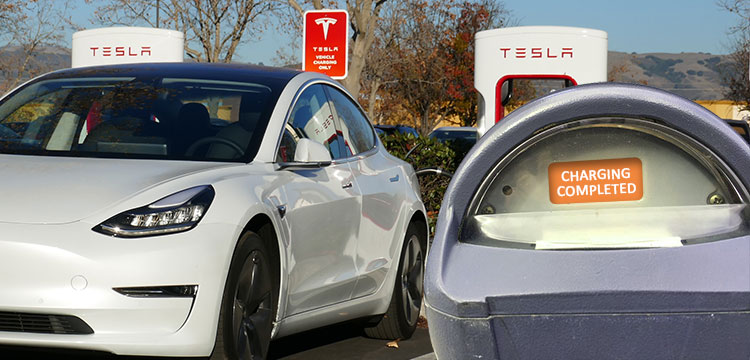
All owners are subject to an idle fee if you remain parked after your vehicle has finished charging. There is a 5-minute grace period. If the car is still not moved Tesla will charge you $1.00/minute ($60/hour) from when the vehicle completed charging. The fee is waived if the Supercharger is less than half full, but it still common courtesy to move your car once charged. You can use the Tesla phone app to alert you, via notifications, when charging is complete.

Depending on the vehicle and program you are in, there can be a usage fee. These vary by state, province, and country. It is usually billed by kWh consumed, but a few areas require billing by time. Pricing is quite low, often lower than residential rates, and far cheaper than gas or diesel for the miles traveled. For more on fees, visit Tesla’s Supercharger Support page.
V3 Supercharger
The V3 Supercharger uses a single cabinet to handle about 1 MW of power. It can distribute up to 250 kW per vehicle in 4 stalls. Almost all new Tesla vehicles (S/X/3/Y) can take advantage of this extra power with a charge rate as fast as 1000 miles per hour. For most vehicles, this equates to 75 miles of charge in 5 minutes. The S/X made in May 2019 or later can get 200 kW charging at a v3 Supercharger. The S/X Long Range Plus can get 225 kW peak charging power, and the latest S/X made after July 2020 can charge at a 250 kW peak rate.
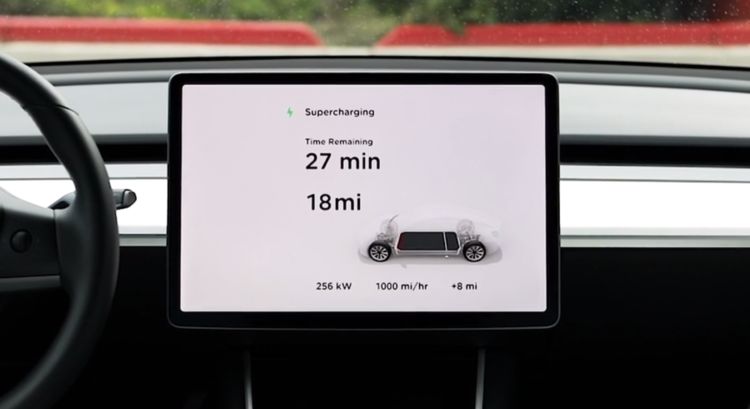
V3 Stall Limitations
The V3 Supercharger has a maximum grid power input of 350 kW and local battery storage input of 575 kW for a combined maximum input of 925 kW. Assuming a 5% conversion loss, this means 878 kW is available to four stalls. Now that assumes the battery has not been depleted. There could be a heavily used situation where the battery has been depleted, and then only the AC input is available, for a 350 * 0.95 = 332 kW that is available for the four stalls.
So you could have three Model Y cars charging at 250 kW, and a forth Model S 75 charging at 120 kW. It is unlikely four cars would converge on four stalls at the exact same time with very low SOC that would limit the power to one or more cars. In most cases, every car will get the maximum power they need.
Cable Length
The cable is slightly over 6 feet in length.
Magic Dock CCS
Tesla has introduced a modified pedestal that includes an integrated CCS connector option to allow use on cars that do not support the NACS (North American Charger Standard). Those cars that use the NACS, such as all Tesla cars, operate as normal. To charge using the CCS connector, once the vehicle owner connects to the Supercharger via the app, a CCS adapter is automatically locked onto the cable. The user removes the handle from the pedestal and connects to their CCS vehicle.
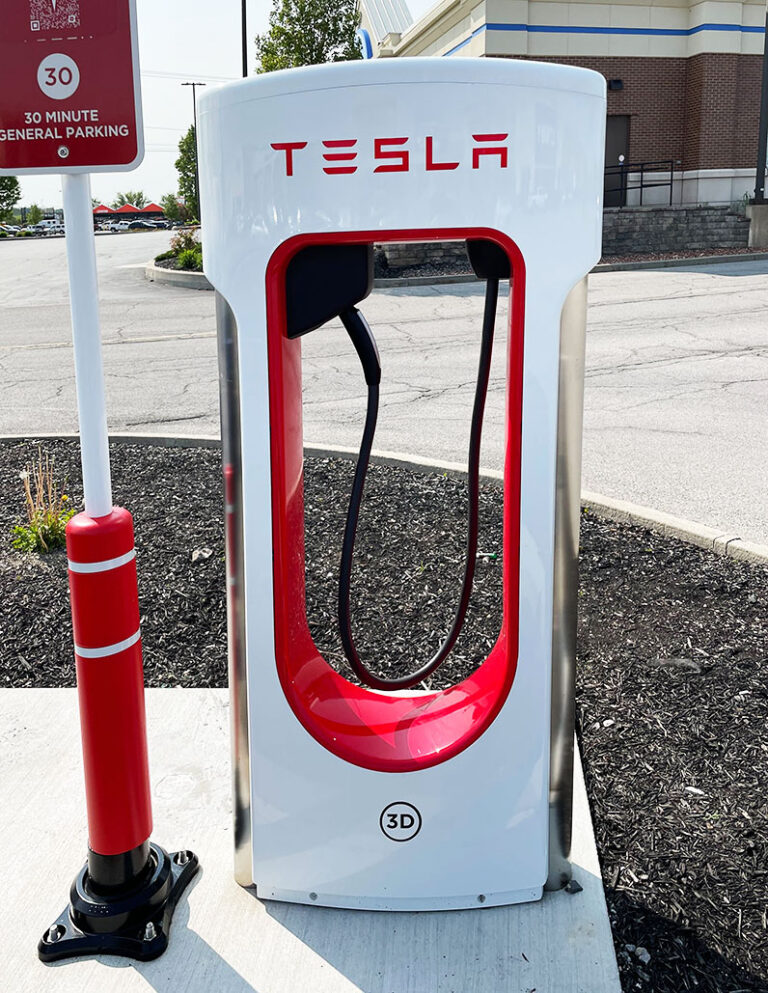
Magic Dock is only currently available at a few locations in California and New York (as of May-2023), but is planned to be rolled out to many more locations. Tesla plans to have over 3,500 connection points in the USA by the end of 2024.
Magic Dock currently offers up to 500V and 250 kW of charging. A few EVs sold (less than 2%) might see faster charging at 800V to 925V at select CCS chargers, if the charger and the vehicle both support higher power. These vehicles normally can also charge at the more common 500V CCS stalls, such as those that Tesla and many alternative companies provide.
V4 Supercharger
In March 2023, Tesla introduced the V4 Supercharger pedestals in Europe. In November 2023, the first North American V4 Supercharger pedestals were installed in Wilsonville Oregon, and Sparks Nevada, and have been expanding to many new locations.
The first V4 pedestal installations use V3 cabinets that provide up to 500V and 250 kW to each pedestal. Tesla increased this to 325 kW in March 2025.
Each cabinet supports up to 8 pedestals.
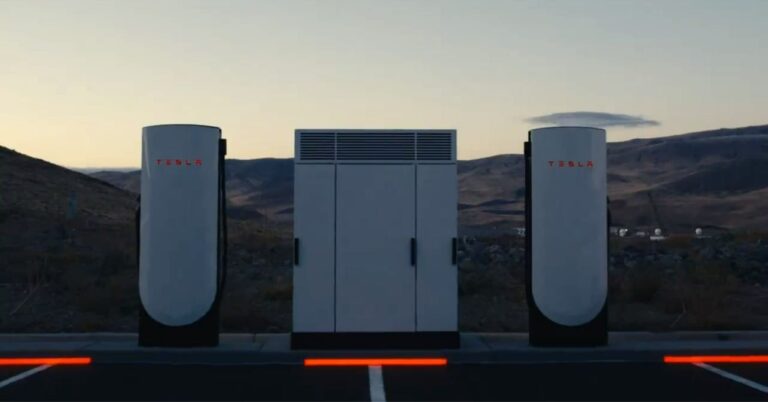
Cables
They use a new 10-foot immersion-cooled cable that are lighter and longer than the 6.5-foot cables on the V3 pedestals.
Evolution of Superchargers
The first 6 supercharger locations appeared in the fall of 2012 in California. These all maxed out at 90 kW, which was also the limit of the first Model S battery “A” packs. All 90 kW Superchargers have been replaced now.
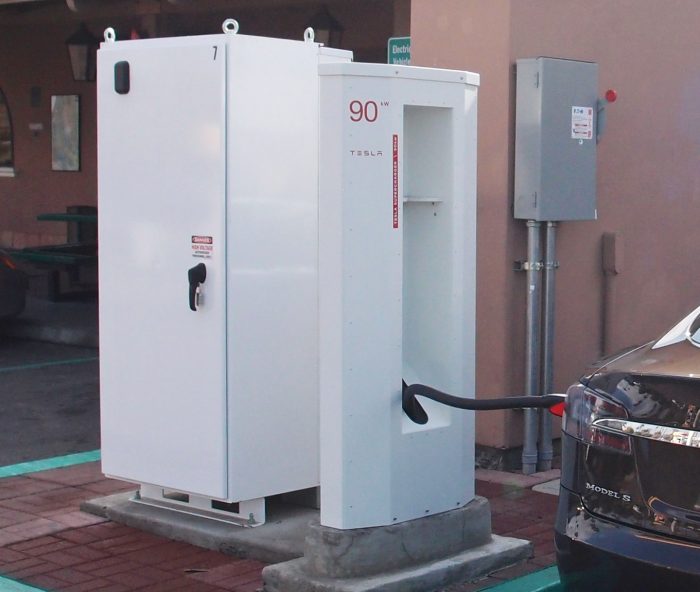
In the Spring of 2013, Tesla introduced the 120 kW Supercharger to match the charging ability of the newer S85 at that time. It has undergone many small design tweaks over the years, to the newest style with the illuminated “TESLA” on top as shown at the top of this article.
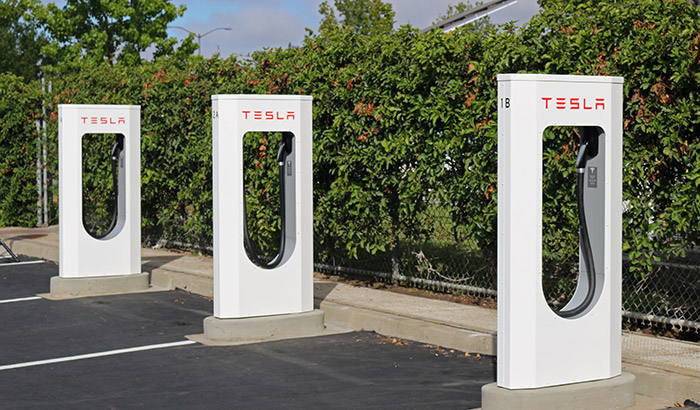
For a few months, Tesla tried out a liquid-cooled Supercharger cable in Mountain View, CA. These cables were noticeably thinner and easier to handle. They did work, but at some point, Tesla reverted to the prior design. Perhaps they were not as reliable. They have since appeared with the version 3 supercharger pedestals.
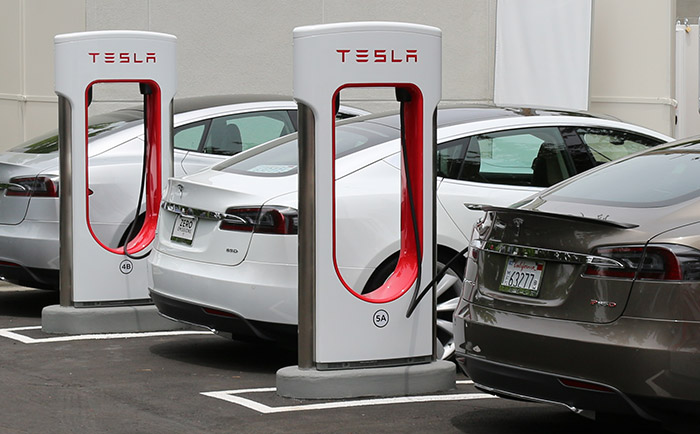
Sometime in 2016, Tesla introduced a Gen II Supercharger, with 135-150 kW power. Each vehicle is limited up to 150 kW, but it will charge two vehicles sharing the same Supercharger slightly faster. We suspect there is still a mix of 120 to 150 kW Superchargers, but in our 2017 travels, we couldn’t find any 120 kW Superchargers.
In late 2017, Tesla introduced an urban Supercharger that is limited to 72 kW. This appears to use a 145 kW Supercharger cabinet for two pedestals but is configured to split the power evenly all the time. You don’t need to worry about which stall to choose. A new smaller pedestal design also appeared with the urban supercharger.
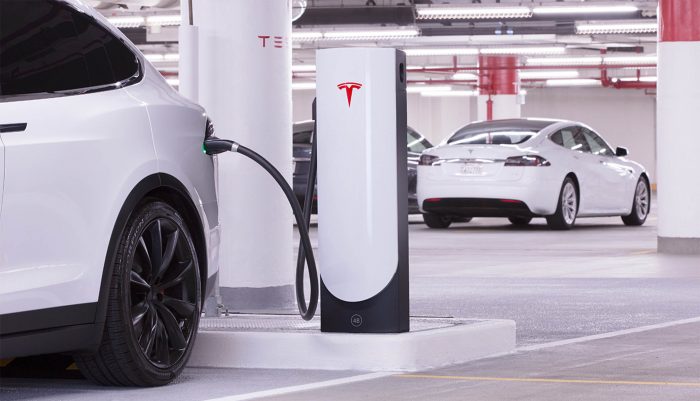
In March 2019, Tesla introduced the new V3 Supercharger, a 1 MW cabinet that can provide up to 250 kW to each stall without pairing. This is rolling out to new Supercharger locations first and the oldest 120 kW stations. The pedestals are similar to V2 but use thinner, liquid-cooled cables.
The new V4 Supercharger pedestal was introduced in Europe in March 2023. V4 pedestals came to North America at the end of 2023. In March 2025, all V4 pedestals support up to 325 kW and 500V.
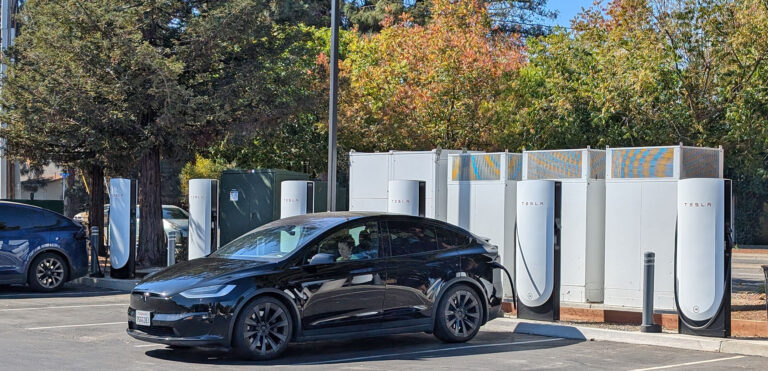
Inside the V2 Supercharger
Supercharger Cabinet
There are 12 chargers within the cabinet along with a couple of large circuit boards.
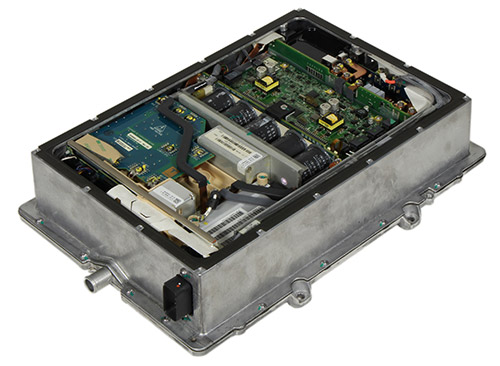
In the 120 kW Supercharger, these charger units were like the ones in the pre-refresh Model S. (i.e. 12 * 10 kW = 120 kW). The European chargers were rated at 11.25 kW as are the newer 48-amp S/X chargers. Twelve of these yields 135 kW total power. The newest urban chargers appear to use a 145 kW cabinet.
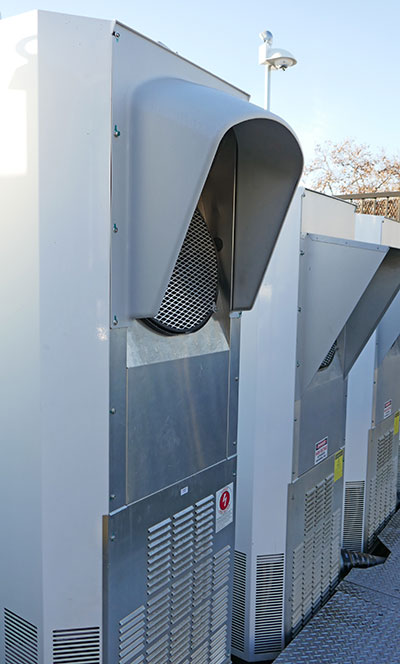
More V2 Supercharger Cabinet Facts
- The Supercharger can route power in 1/12 increments to either the A or B pedestals.
- Each charger module is liquid-cooled. It’s unclear if a refrigerant cooling system is used, or just a pump/fan/radiator system. We suspect the latter.
- The cabinet uses 3-phase power at 277V per phase, or also called 480V. To get 480, multiply 277 by the square root of 3.
- A typical 480V installation is supplied power through a 250 amp 3-phase breaker.
- A single cabinet weights 1320 lbs.
Supercharger Cabinet Label
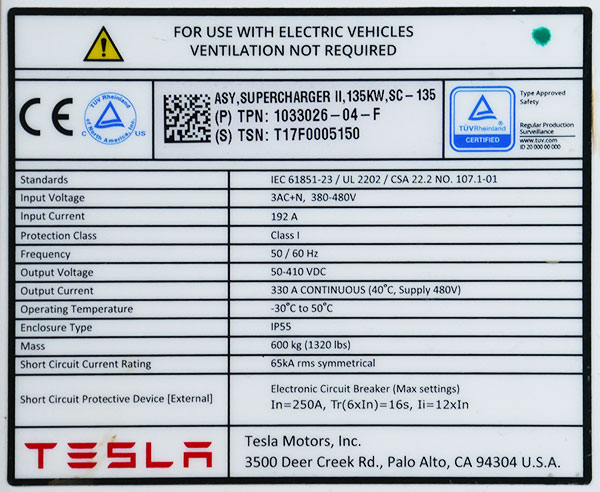
Pedestal Charging Post
The Illuminated “TESLA” at the top is backlight with LEDs that in total take 4.3W.
From the Supercharger Cabinet to the Post has 5 signal wires, a low voltage line, and four high power DC lines (doubled power), and two grounding conductors. These are fed through a 3” diameter conduit.
The cable to the connector uses two sets of two smaller high-power DC lines, a ground, and 2 signal wires. This is routed to the 5-pin connector (North America and Asia). Europe uses the 7-pin Type 2 Mennekes connector.
Typical Installation (only 2 pedestals shown)

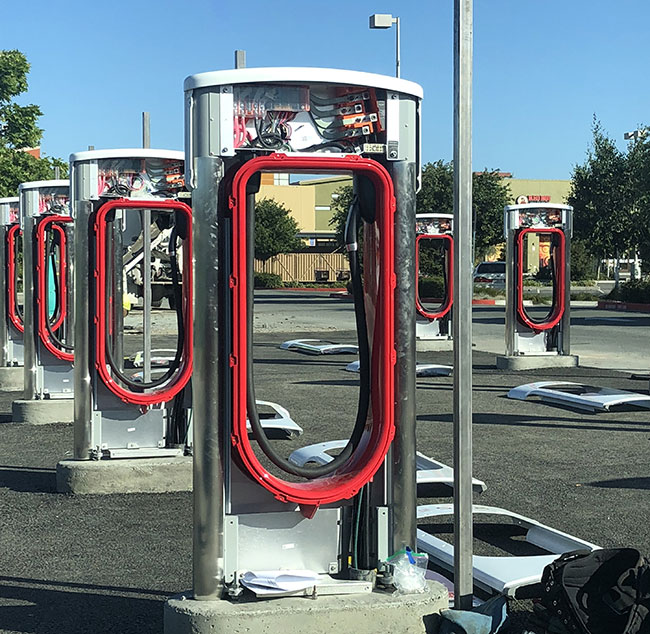
Inside the V3 Supercharger
The first version 3 Supercharger went into public service in June-2019 at Fremont California. Here’s an inside view of a single V3 Supercharger cabinet being installed, which handles 4 stalls.
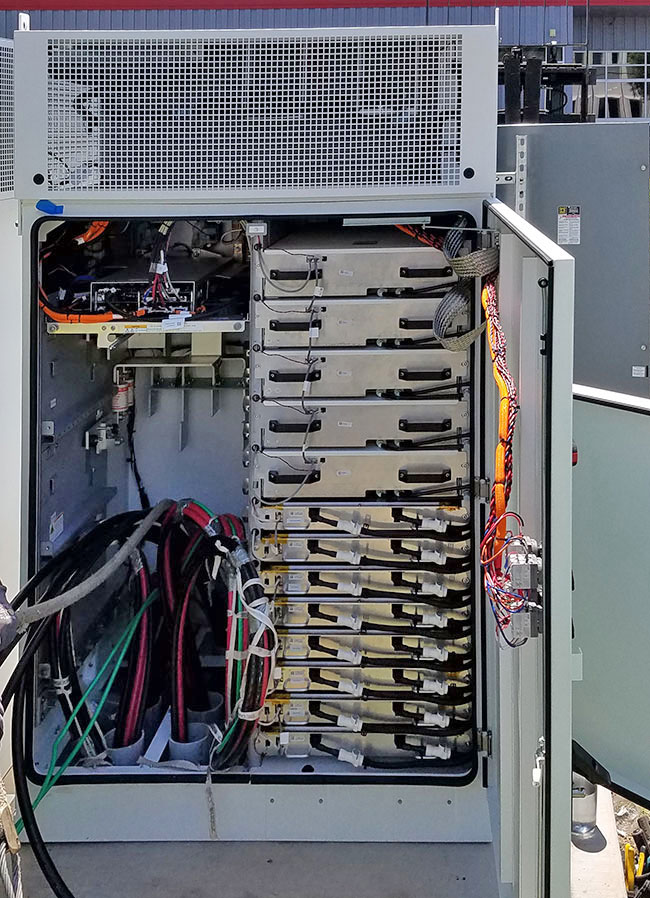
The Fremont installation uses two cabinets for 8 stalls. The cabinets are similar in size to those used for Tesla Powerpacks.
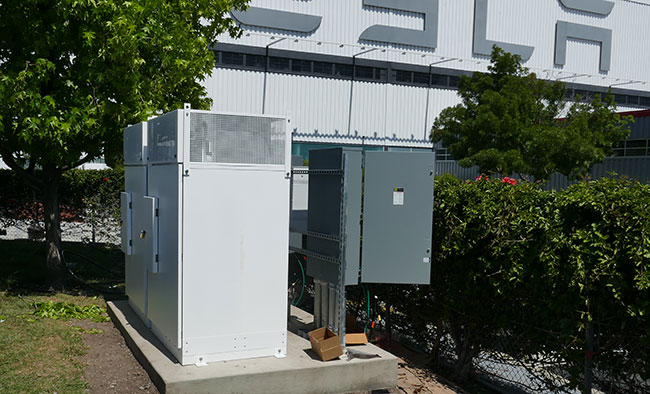
V3 Supercharger Cabinet Label
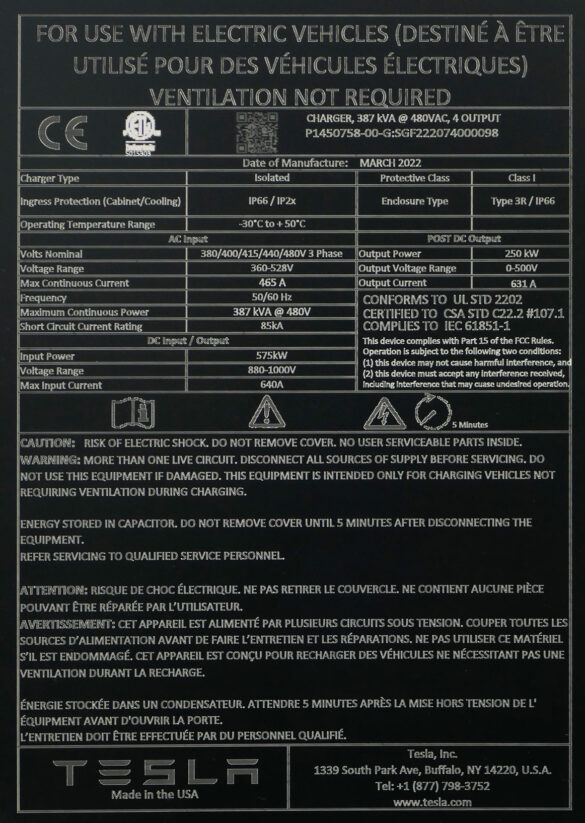
Liquid Cooled Cables
The new 1 MW V4 Superchargers use a new cable with directly cooling the cooling cable conductors, a different design than the prior V3 Superchargers with isolated liquid cooling lines.
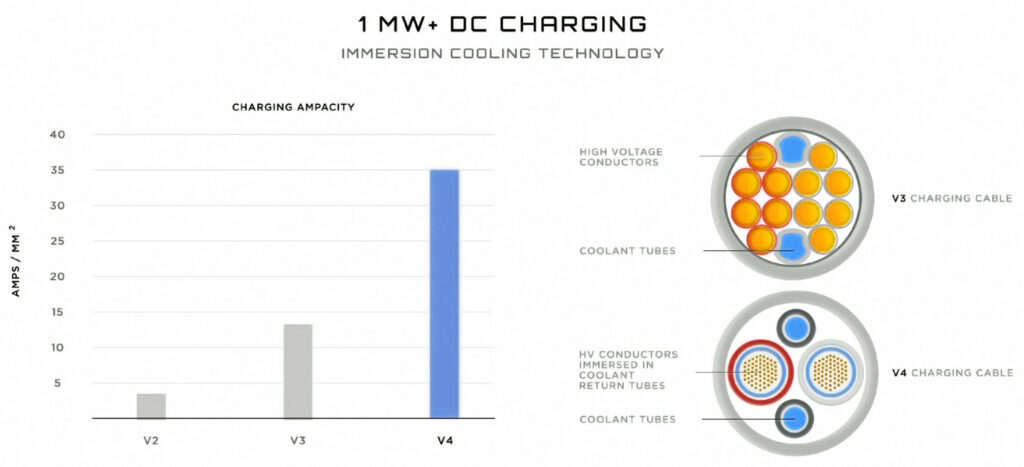
Common Questions
Q: How long to charge?
A: This depends on the current state of charge, charging power, and what level you set to end charging. When you start charging, within a couple of minutes, the instrument display and the Tesla phone app will show how long it is expected to take.
Q: I’m having trouble getting the charge connector in (or removing it). How can I fix this?
A: First the ring color must be white (or light blue) to insert or remove the connector. If any other color, depress the button until the color changes and then insert/remove.
If the vehicle is new, some charge ports are very tight. You might need to apply quite a bit of pressure. Usually, within a month it becomes easier. If it truly is too hard to use, contact service to have the port replaced.
In all cases, check if the connector is damaged or dents in the connector. Although rare, in a few cases a Supercharger connector was dropped, denting the connector edge. You can try another stall. It’s helpful to alert Tesla to the issue with the location and pedestal ID, like “4B”. Customer service is at 1 (888) 518-3752.
When trying to release when pressing the connector button, if the port will not unlock (turn light-blue), try using the fob (Model S/X) by holding the trunk button in for 1-2 seconds or within the car, Controls -> Charging, tap the unlock charge port. On rare occasions, the charge handle button just doesn’t work, perhaps due to radio frequency interference.
Q: The charging seems quite slow – what can I do?
A: This could be normal. If you are the 2nd vehicle connected to the Supercharger, you may get a low rate (see Picking the Right Stall at the top). If you are above 70% SOC, this also limits the charging speed (see Tapered Charging above). Lastly, it could be the battery is very cold or very hot and the temperature must be brought within band to allow charging at the full speed (this is all done automatically).
In rare instances, there could be a problem with the Supercharger. If there are other stalls free, you can try another stall. It’s helpful to let Tesla know about problems. They are very proactive in keeping the equipment functioning properly.
Q: Why are the fans running in the front of the vehicle while charging?
A: When either the outside temperature is hot, and/or the battery gets hot from fast charging, the battery is automatically cooled by turning on the AC and the fans in the front of the vehicle. Sometimes this can be quite noisy if maximum cooling is required.
Automakers Supporting NACS and Superchargers
Tesla created the NACS (North American Charging Standard) to further expand Supercharging by other automakers. As non-Tesla EV manufacturers learn how critical it is to have reliable and convenient charging, they are switching to NACS over the dismal CCS system. Vehicles equipped with NACS can also use CCS with an adapter, but we expect few want to downgrade to the poor CCS charging experience. SAE made the related J3400 standard from Tesla’s NACS system.
Automakers Integrating NACS
Aptera Motors – They are using NACS in all their automobiles from the start. Aptera’s NACS press release details.
Audi – Announced switching to NACS in 2025. This is the related NACS News Release.
BMW – Announced switching to NACS. BMW Group’s NACS News Release.
Fisker – Announced switching to NACS in 2025. Fisker’s NACS News Release.
Ford Motor Company – They are switching to NACS and dumping CCS. They are working to switch over new vehicles to using the NACS around mid-2024. They will also offer an adapter to all prior Ford EVs that provides NACS access to Ford vehicles that use the old CCS connection.
General Motors – They are also switching to NACS. The first cars with NACS will appear in 2025, with adapters available to all GM owners in early 2024. GM’s NACS Press Release details.
Genesis – Announced switching to NACS in late 2024.
Honda & Acura – Have confirmed they are switching to NACS in 2025 or 2026 in an Interview.
Hyundai – Announced switching to NACS in late 2024.
Jaguar – is switching to NACS in 2025. Jaguar’s NACS Press Release details.
Kia – Announced switching to NACS in late 2024.
Lexus – Announced switching to NACS in 2025. Toyota/Lexus Press Release details.
Lucid – Announced switching to NACS in 2025. The Lucid press release was removed in April 2025, so it is unclear if they will switch to NACS.
Mazda – Announced switching to NACS in 2025. The Mazda Press Release details.
Mercedes-Benz – Has announced switching to NACS by 2025. Mercedes-Benz NACS Press Release details.
Mini – Announced switching to NACS in 2025. BMW Group’s NACS News Release.
Nissan – Announced switching to NACS by 2025. Nissan’s NACS Press Release details.
Polestar – Announced switching to NACS by 2025. Polstar’s NACS Press Release details.
Porsche – Announced switching to NACS in 2025. This is the related NACS News Release.
Scout Motors – Announced switching to NACS in 2025. This is the related NACS News Release.
Stellantis – Announced switching to NACS in 2025 on select models. The Stellantis J3400 Press Release.
Subaru – Announced switching to NACS by 2025. Subaru’s NACS Press Release details.
Rivian– They signed an agreement to switch over to NACS in early 2024. Rivian’s Twitter announcement.
Rolls Royce – Announced switching to NACS in 2025. BMW Group’s NACS News Release.
Toyota – Announced switching to NACS in 2025. Toyota/Lexus Press Release details.
Volvo – Announced switching to NACS by 2025. Volvo’s NACS Press Release details.
Volkswagen – Announced switching to NACS in 2025. This is the related NACS News Release.
Charging Companies Supporting NACS
- Blink – Announced support for NACS in June 2023
- ChargePoint – Announced support for NACS in June 2023
- Electrify America – Announced support for NACS in June 2023
- EVgo – Has offered NACS charging since 2020 and has announced expansion plans for NACS in June 2023.
- Flo – Announced support for NACS in June 2023.
- Kenpower – Includes NACS in all its charging solutions, announced in June 2023.
- Tesla has the most extensive NACS network, which was started in 2012.
- Tritium – Announced support for NACS in June 2023, but in May-2025 has removed all site references to NACS for unknown reasons.
Supercharger Related Links
- EV Trip Planner – Tesla specific mapping for your model type as well as routing through Superchargers – Considers current traffic, temp, speed, and elevations!
- Introducing V3 Supercharging – Tesla Blog
- North American Charging Standard – Details on Tesla opening up the NACS to all companies and links to technical standards
- PlugShare – Includes Tesla Superchargers and other chargers
- Supercharging, CCS and CHAdeMO DC Fast Charging – Our comparison guide
- Supercharger Map shows Superchargers in North America along with those under construction and those with permits.
- Tesla Interactive Supercharger Map – You may need to first log into your Tesla account to view this.
- Tesla Trip Planner – Enter start and end locations, and it does the route with Supercharging stops and the estimated time to charge. It does not support discontinued models.
20 comments
The Big Island of Hawaii does not have a supercharger. We have many destination chargers, making for long charge times. What are the criteria to have a Supercharger installed?
I’m guessing it is mostly based on the number of Teslas in an area and likely travel routes. Oahu finally got one last year, but that’s the only one I’m aware of for the islands. I don’t know if it will help, but I recommend suggesting a location here: https://www.tesla.com/suggest-superchargers
If you drove around the entire island, it would be around 200 miles. Superchargers are meant to be used for long road trips, so a supercharger would not be necessary for any road trips on the island. However, if you are an Uber/Lyft driver, or don’t have a place to plug-in overnight, then you would need access to a supercharger. But this would not be “typical” usage, so I can see why Tesla would prioritize other areas first.
Can one V3 cabinet provide 631 amps to an 800-volt vehicle, or does it take two cabinets working in series to charge an 800-volt vehicle at 631 amps (if such a vehicle ever exists)?
I’m unaware of any way a V3 cabinet can provide more than 500 volts, and I don’t think they can be strung in series. Every indication is Tesla is remaining with systems that are 500v or below. For example, the 2020 S/X uses 400v, and the newer 2022 S/X uses 450v. Perhaps they will go to 500v with some future vehicle, which theoretically can handle 315 kW with existing V3 Superchargers. The Semi uses a different system, and it may use a higher voltage too.
I guess I was assuming both V2 and V3 Superchargers were somehow connecting in series to enable charging an 800-volt Porsche in the Netherlands. If not, how are they pushing any current into an 800-volt vehicle with just 500 volts?
Tesla chargers provide a maximum of 500v. The Taycan has an option to charge at 400v by switching the pack from two 400v packs in series (i.e. 800v) to having the two sections in parallel (400v). There are many older CCS chargers that are also are limited to 500v. If an EV requires only 800v, they can’t charge at a Tesla Supercharger (in Norway), nor at many existing CCS chargers.
There are times, when traveling, that I would like the car to be charged slower so I can have breakfast or lunch. Any advice ?
I’m not aware of any way to slow the charging, but if there is a mix of V2 (150 kW) and V3 (250 kW) stalls, selecting a 150 kW stall will be slower for new cars. In addition, you can set your charging to 100%, which can take a lot longer as the charge rate slows as you get near 100%.
I hear almost everyone say to keep the charge between 20% and 80% at home, but when I picked up RedSilk, the Tesla Customer Rep said 90%. My good friend doesn’t have far too drive to work so he only charges on Wednesday nights. But, again, my Customer Rep said to plug it in whenever I’m at home. What is the best approach?
I personally use 90%, per Tesla’s recommendation for the last 7+ years in two cars. At the same time, it’s recognized that 50% is generally the optimum long-term charging point for the best longevity. I suspect the difference between 50% and 90% is less than 1% over 10 years. So 50% is better, but such a slight amount to not really be all that meaningful. Everyone agrees 100% is not ideal, but then again I think the harm is blown way out of proportion. If you need 100% – don’t be afraid to use it. If you don’t need it, then set your charge to 90% or below.
This is a great compendium. Thanks much!
I’m struggling with lowered supercharging speed for an older 2013 Model S. Have posted another comment on that. I would really like to know more about how Tesla implements its charging rate curve in response to temperatures and “battery condition”.
So far Tesla has not disclosed any details relating to charging rate and temperatures and battery life.
Need to update this article with the slower supercharge rates for all older models, regardless of battery age or size. This refers to S40/S60/X60/S70/S75/X75/S85. Not sure if the reduced rates also apply to S90/X90 batteries.
I’m holding off for now, as it’s unclear if this was a temporary issue, an issue with select superchargers or something else. In some reports, older models have gotten a significant upgrade in charging speeds. I’ve personally seen my S75 that has had a ~100 kWh maximum for years now peaks at 122 kWh on V2.
My car is a 60kWh (original 2013). My max supercharger speeds are about 60-64kW. I have rarely supercharged so haven’t noticed this until recently but having Tesla look at it in case there is a problem with the car… if they tell me it’s normal then this chart on speeds will need to be updated…
As noted above, there are many factors that affect Supercharging speed including the SOC, temperature of the pack, others using an adjacent stall and more. Rare, but on occasion, some Superchargers are not producing full power too. Sounds like one of these factors may be at play.
It’s very clear that it’s a permanent issue, as I’ve been struggling with it since 2017, when Tesla admitted they were throttling older cars based on something related to amount of supercharging done or “internal battery conditions” that were unspecified.
Mine is a 2013 Model S85, which initially charged at 115+ kW at low SOC, and tapered to about 60 kW at 60%. Now it charges at about 80 kW at low SOC, then tapers to about 50 kW at 50%. That makes much more difference than the 5 minutes Tesla suggests.
I’ve done enough supercharging to know which stall to plug into and when to suspect site conditions (e.g. 40C weather). I don’t know of anyone who notes an improvement in this situation. The irony is that my Model S has had a very low rate of supercharging use; basically just a few long distance (1000 km) trips per year. Otherwise, it is always garage charged at 10 kW to 90%. It retains 98% of its initial capacity as judged by the rated range indicator.
I find this pretty damned disturbing, and I wonder if Tesla could not at least keep the rate high out to a higher SOC, even if they have to reduce the maximum rate at low SOC. I think we should expose this in the press and press them to do as much as possible to cure it. Without such encouragement, they mainly have an incentive to keep doing this and thus pressure people to trade in for newer models.
I’m not sure if permanent, which vehicles may be affected or what usage situations may relate to what you’re seeing. Is your S85 an early 85 with an “A” battery? These used to be limited to 90 kWh, but if you were getting 115 kWh, I’d guess you don’t have an “A” pack.
My current 2016 S75 actually got better over the last month. I used have a maximum charge rate of 85-95 kWh, but over Thanksgiving, I got 122 kWh at a V2 Supercharger, which I’ve never seen before. My usage is fairly normal, with about 5 trips a year using Superchargers.
This is a great one-stop-shop for everything Supercharging.
Thanks.